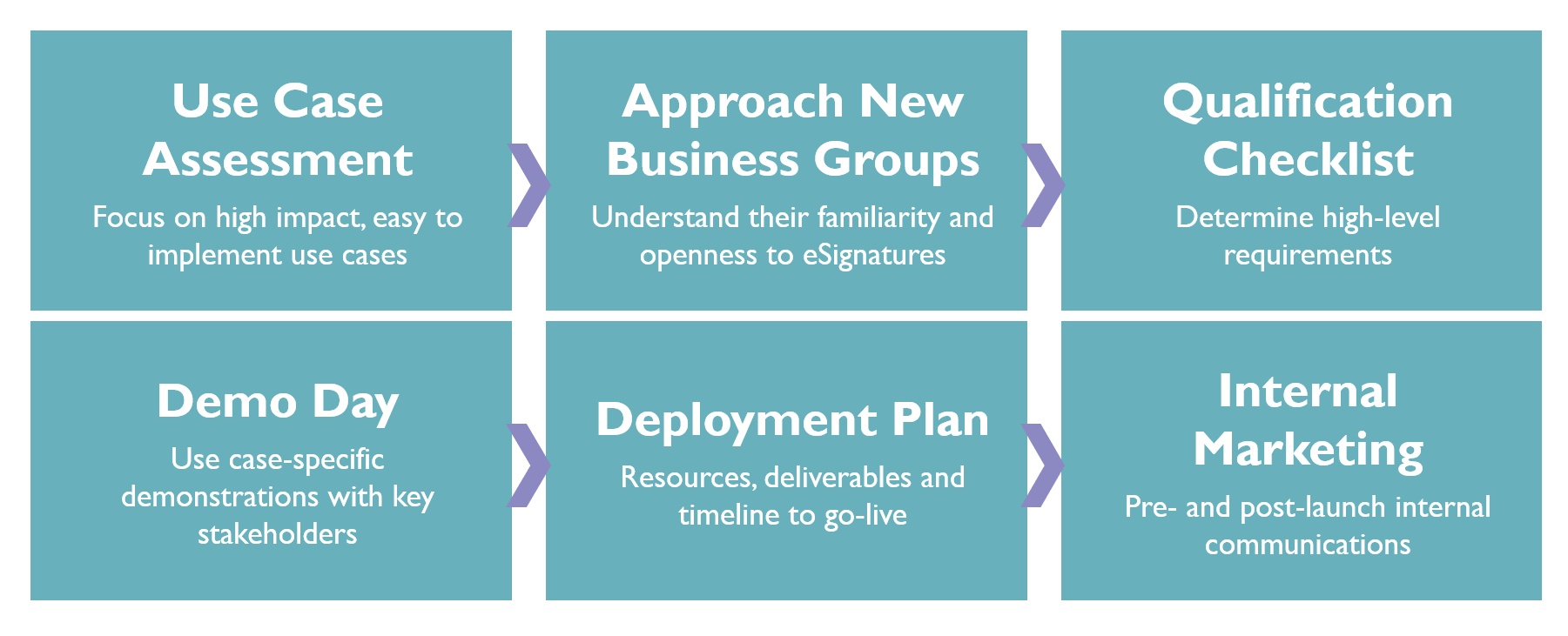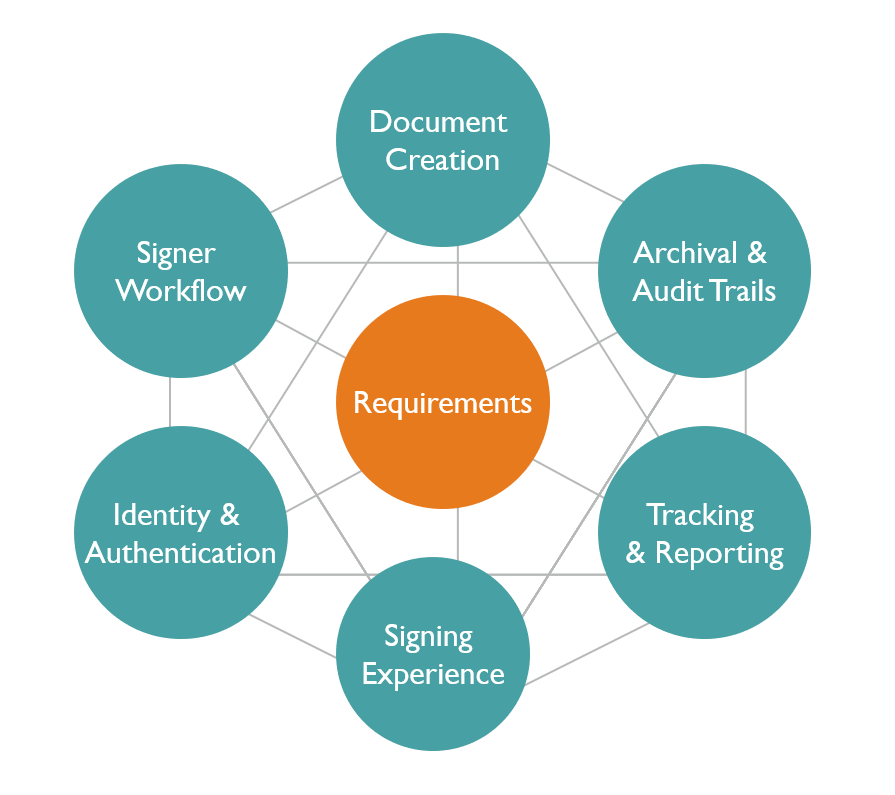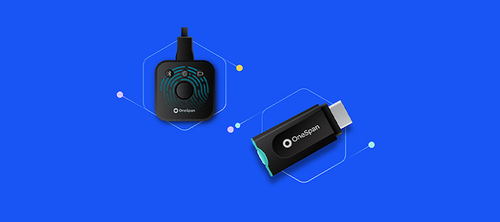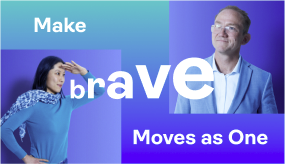Best practices for an easy enterprise eSignature expansion methodology

Your organization is now probably quite comfortable with eSignature use, digital signature security, and has experienced benefits across a broad range of use cases spanning B2E, B2B, and B2C workflows.
So, what’s next in the digital transformation journey?
Below, we walk through a 6-step process that outlines how to successfully leverage your existing eSignature solution to ensure buy-in from key stakeholders, secure widespread adoption, and build toward a center of excellence. This formal, repeatable process can be applied to help expand the use of electronic signature software across the organization for enterprises, small businesses, and companies of all sizes.
Expansion methodology: A 6-step process

1. Use case assessment
If you’re tasked with leading the digital charge within your organization, the best place to start is to first map out all the possible document signing use cases and opportunities for automation with eSignatures within the business.
Ask yourself such questions as:
- How can I leverage the solution’s APIs as well as pre-built integrations?
- Do my customers typically use Android or iOS mobile devices? Will that impact my workflows?
- Is the solution integrated or a standalone mobile app?
- Can teams easily share notifications and information?
- Are there any high-impact PDF documents or other docs that still require automation?
- Will custom branding of the solution make any one use case more valuable than others at this time?
For this initial exercise, work with stakeholders from different corners of your organization to earmark the easiest use cases with the highest impact. ROI impact and implementation speed should be key parameters in the evaluation process. Look for quick wins that will showcase the best value.
A great B2C use case to consider is wealth management. The consumer-facing transactions linked to customer acquisition, growth, and retention initiatives have the potential for high ROI. Implementation speed is quick, with interactions usually being person-to-person or user-initiated, and don’t require integrations within existing systems to launch. Wealth managers can typically log into OneSpan Sign and begin sending agreements immediately.
Example: Wealth management
- ROI impact: High
- Consumer-facing (B2C)
- Aligned to ongoing customer acquisition efforts
- Implementation speed: High
- User-initiated
- No integration required
- Considerations:
- Templates to accelerate document preparation
- Know your customer (KYC) compliance requirements
- How the signing will take place, i.e., remote or in-person
- White labeling, to keep your brand front and center
2. Approach new business groups
Once your priority use cases have been identified, it is now time to approach business units to understand their current signing processes, any pain points or issues within their workflows, and highlight how eSignature functionality can benefit them. The key here is understanding any barriers to adoption or current challenges, which may explain why they haven’t considered electronic signatures. Sharing internal success stories or anecdotes from industry peers can also help evangelize the benefits and shed light on use cases that may not yet be live within your organization.
3. Qualification checklist

Dive a bit deeper and document the specific requirements for each identified use case. Capturing this information up front is an important foundational step. Ask questions like:
- How will each transaction be initiated?
- What authentication method should be used to verify signers?
- Are signatures required from every recipient or are some optional?
- Which documents should be visible or hidden to certain participants during the signature process?
4. Demo day
This is a great opportunity to promote your case internally. Develop use case-specific demos for influential stakeholders within your organization, including executive sponsors, business owners, and representatives from finance, IT, security, and legal and compliance. Features such as the detailed audit trail will be of great interest to these groups.
A typical demo day agenda should include an overview of your initial eSignature use cases, success outcomes, the rationale for targeting this specific line of business, next steps in the implementation process, and plans for future implementations to maximize value and benefits.
5. Deployment plan
This step is all about accountability. Ensure you keep the project on track and that key milestones and deliverables are transparent to stakeholders. Building a deployment plan for your electronic signature initiative should always include the following components:
- Project schedule
- Project lifecycle, organized by phases
- Key deliverables and milestones
- Work breakdown, organized by required tasks to complete the project
You should be able to easily replicate this process for future deployments to build and expand the use of esignatures across your enterprise.
6. Internal marketing
Evangelize what you’ve built with your electronic signature solution. This will enable you to gain better traction and momentum for future eSignature projects.
Organizations that leverage internal marketing often get better results and see higher adoption rates among teams when they make use of internal tools like launch events, weekly usage reports, tutorials, and professional development activities for staff. When eSignature use takes off internally, your employees will help drive the right set of behaviors for customers who now expect the ability to easily and securely interact and do business remotely. Overall, make sure to highlight what’s driving the change and keep your teams updated, engaged, and informed throughout the implementation process.
What about compliance?
When establishing an enterprise electronic signature strategy, it is important to ensure compliance with each new deployment. Regulations may differ by country and locality, but whether OneSpan Sign, DocuSign, SignNow, Pandadoc, Hellosign, Adobe Sign, or any other electronic and digital signature solution, they are subject to these regulations. In the United States, electronic signatures are defined and regulated by the Electronic Signatures in Global and National Commerce Act (ESIGN Act) and the Uniform Electronic Transactions Act (UETA). The EU follows the eIDAS regulation. Legislation exists in countries around the world and determines the requirements of the signature service or signature platform.
In addition, other certifications, such as HIPAA compliance, will also be relevant to your digital documents and document management systems.
For more information, refer to the OneSpan eSign Legality Guide.
Conclusion
When exploring your eSignature roll-out, think past initial pricing to the goal of eventual enterprise-wide adoption. This is a best practice that will provide a level of uniformity and standardization to your plans.
By establishing a proper methodology and building once before scaling across different use cases, channels, and lines of business, you can increase efficiency, avoid siloed deployments, and greatly reduce the maintenance costs and time required to digitize new use cases as they come online.
Standardizing your tech stack and establishing a centralized point of service will help reduce complexity and time-to-deployment, and ensure ease of use for cost-effective new eSignature applications, freeing up more time to focus on transformational goals while gaining more value over time.









